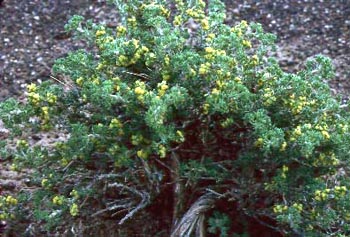Bud Sagebrush

Common Name(s):
Bud Sagebrush
Budsage
Bud Sage
Scientific Name:
Picrothamnus desertorum Nutt.
Scientific Name Synonyms:
Artemisia spinescens (DC.) Eaton
Symbol:
PIDE4
Description:
Life Span: Perennial
Origin: Native
Season: Deciduous
Growth Characteristics: A low growing, highly branched, spiny twigged shrub with a rounded crown, growing 2 to 18 inches tall. It has a strong odor. It flowers March to June, reproduces from seed.
Flowers/Inflorescence: Flower heads are on short, leafy branches, and are pale yellow.
Fruits/Seeds: Seed is oblong and densely hairy. Seed production is infrequent because the flowers bloom quite early and are often damaged by frost.
Leaves: Alternate, fan-shaped, with 3-5 linear spatulate lobes, which are again divided. Surfaces are hairy. The buds are large and hairy.
Stems: The older twigs are rigid, thickened, gray to dark brown and shreddy. The newer twigs are ascending, hairy, eventually becoming spines. The trunk is short, gray to brown, and shreddy.
Ecological Adaptions:
Bud sagebrush grows on desert mesas, hills, and plains, at elevations from 4,000 to 6,000 feet. It is common in salt-desert shrub communities.
Soils: Adapted to a broad range of dry or well-drained soils. It is an indicator of alkaline soils.
Associated Species: Winterfat, shadscale, galleta, Indian ricegrass.
Uses and Management:
Budsage is generally considered a desirable forage species. It is one of the first shrubs to become green in early spring and is highly palatable to livestock. On sheep range, it is one of the most palatable forage plants during late winter and early spring. The early availability provides high quality nutrition during the lambing season. Light grazing in late winter and early spring damages the growth of budsage, and can even lead to its elimination in an area.
Budsage is also an important, palatable, nutritious forage species for upland game birds, and small and big game.
The pollen of bud sagebrush commonly causes hay fever.

